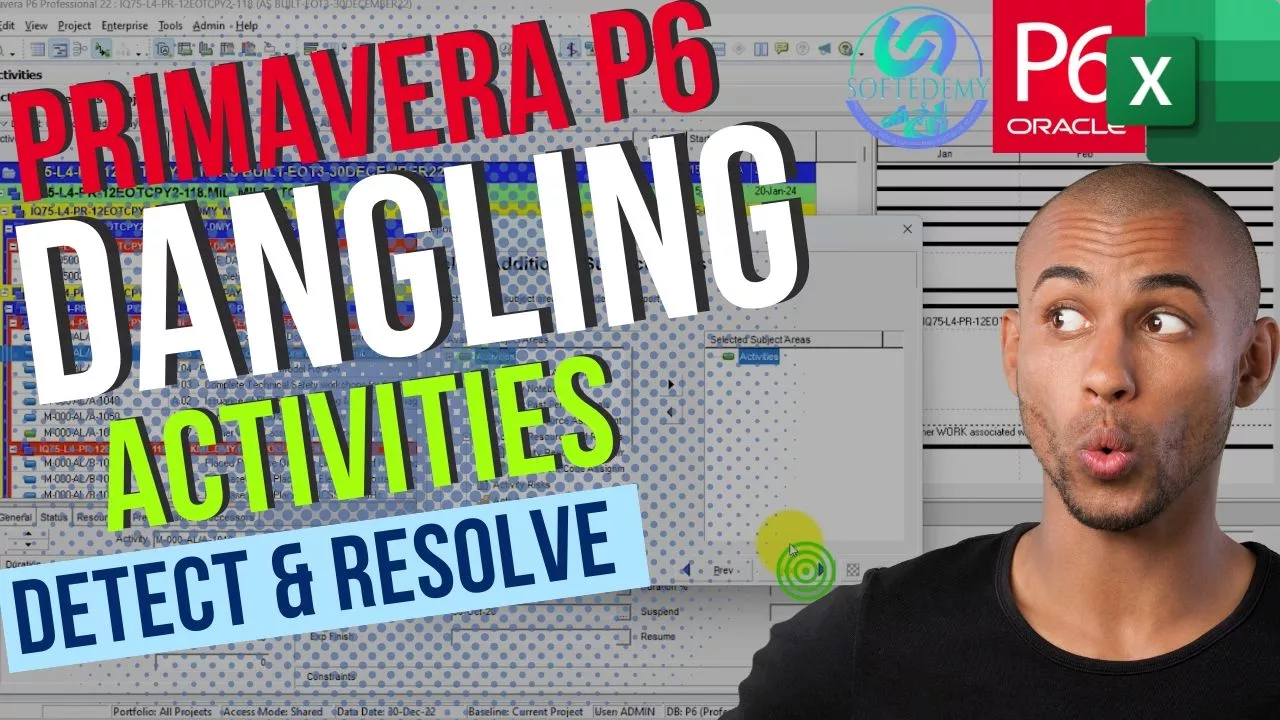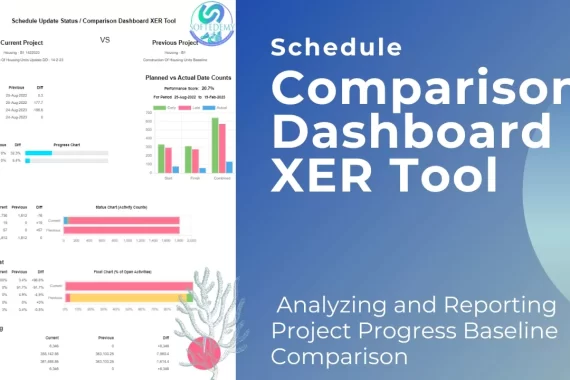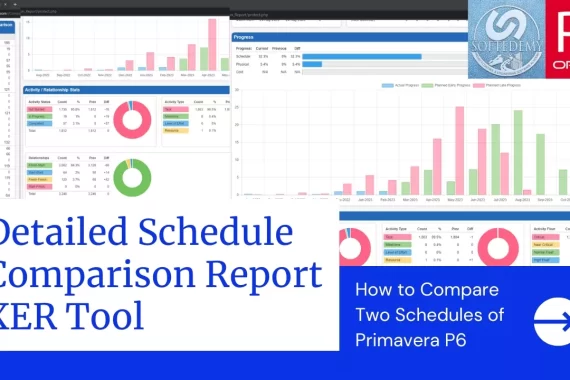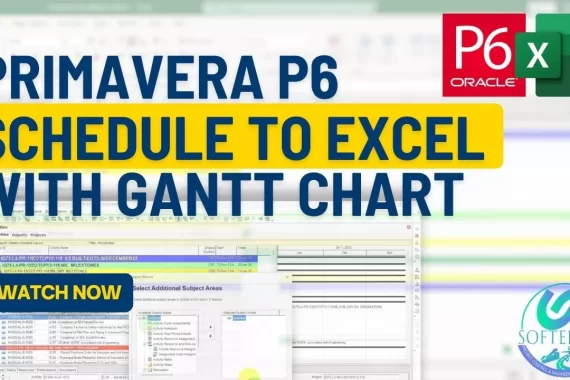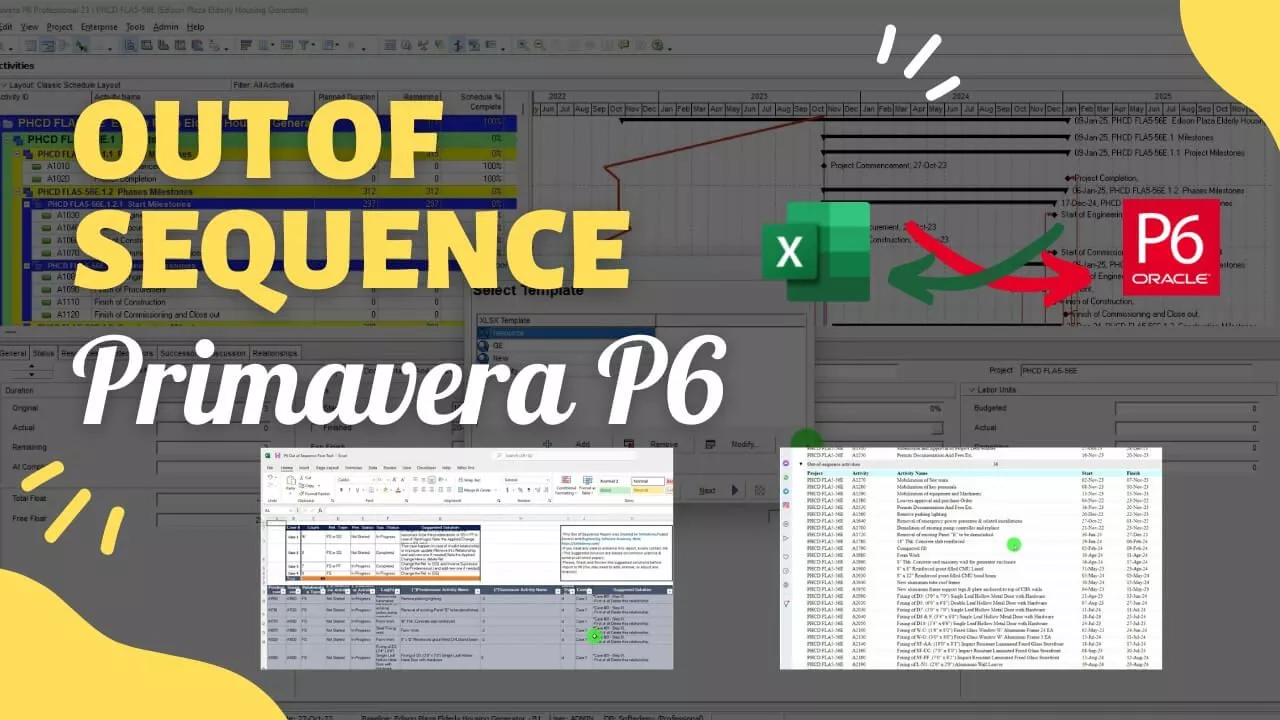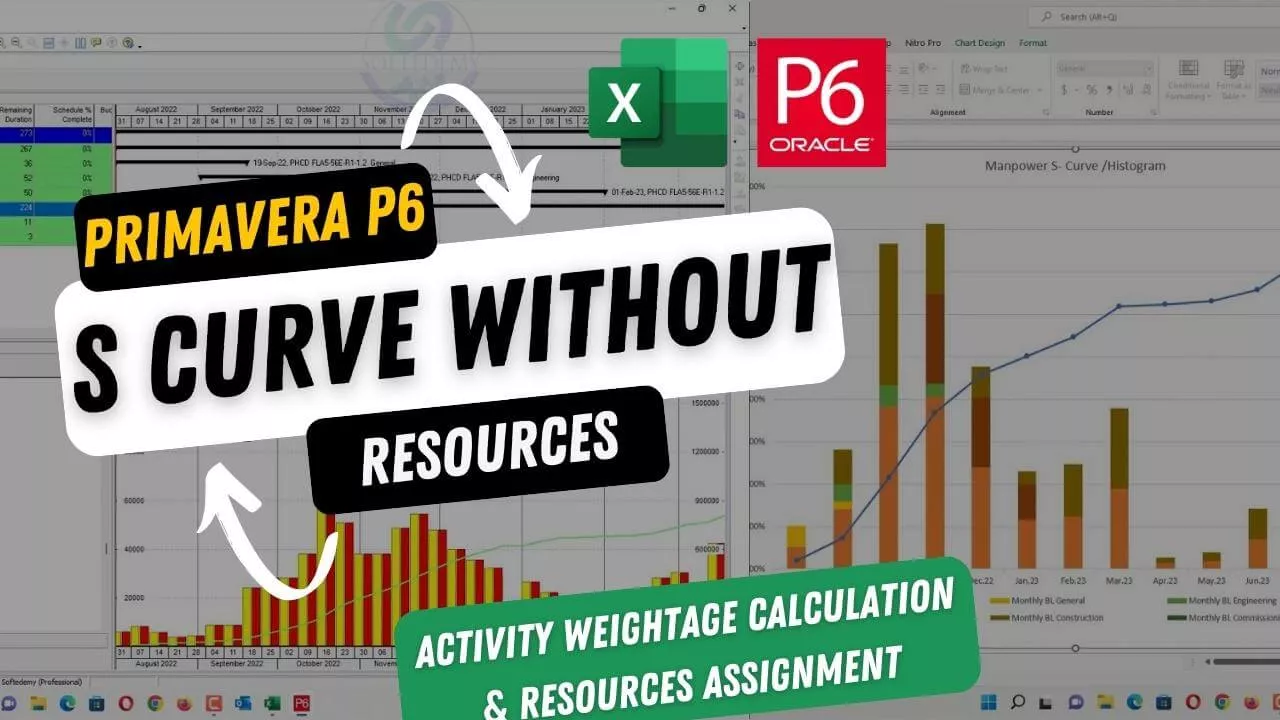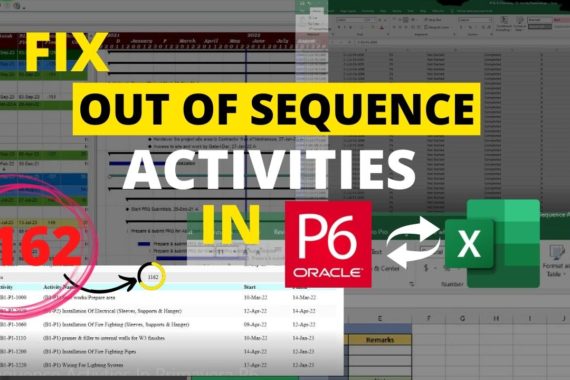Introduction:
This article will discuss the concept of detecting and fixing dangling activities in Primavera P6 and how they impact time schedules. It will provide a definition of dangling activities, examples, and their impact on time schedules.
What are Dangling Activities?
Dangling activities are a type of open-ended activity that has a predecessor and a successor but still dangles from at least one end. In simpler terms, it is linked to other activities but is not governed by the relationships. Therefore, it is considered as an independent activity that does not impact the workflow sequence.
Examples of Dangling Activities:
Dangling activities can be divided into two categories: dangling start activities and dangling finish activities.
Dangling Start Activities:
A dangling start activity is an activity with a “start end” that is not governed by its predecessor relationships. It could have a relationship with its successors such as SS or SF but is still dangling because no activity in the network controls its start.
Dangling Finish Activities:
A dangling finish activity is an activity with a “finish end” that is not governed by its successors relationships. It could have a relationship with its predecessors such as FF or SF but is still dangling because it can finish anytime without affecting other activities in the network.
Impact of Dangling Activities on Time Schedule:
Dangling activities can significantly impact the primavera P6 time schedule of a project in , leading to inaccuracies that can potentially result in wrong critical paths and incorrect milestone and completion dates. Delay or expedition of a dangling end will not impact the project because it is not linked to the workflow sequence, which can lead to fake results of the expected project completion date and/or project critical path.
To address this issue, a Dangling Activities Detector Tool has been created to detect and fix dangling activities in time schedules. The tool is designed to make it easy to identify and fix dangling activities that have the potential to distort the program Primavera P6 with inattention from the scheduler Primavera P6.
Distortion of the Primavera P6 Program Due to Dangling Activities
Dangling activities can cause severe distortions to primavera p6 schedules, leading to incorrect critical paths and milestones, especially for significant projects. Unfortunately, scheduling software like MS Project lack available filters to detect or extract dangling activities, which makes it more probable for them to distort the program. This article explains what dangling activities are, why they are an issue, and how the Dangling Activities Detector Tool can help to detect and fix them, Detecting and Fixing Dangling Activities in Primavera P6 Time Schedule.
Wrong Critical Paths and Incorrect Milestone and Completion Dates
Dangling activities can cause inaccuracies in time schedules that can potentially result in incorrect critical paths and milestones. When an active schedule has dangling activities, it is essential to detect and fix them as soon as possible. Otherwise, the project completion date and the critical path will be distorted, leading to project failure.
The Need for a Dangling Activities Detector Tool
Since scheduling software like MS Project lack available filters to detect or extract dangling activities, a Dangling Activities Detector Tool has been created. This tool can help detect dangling activities in primavera p6 time schedules easily and provide suggestions for linking dangles to fix them. The tool is easy to use and can help to prevent distortion of the primavera p6 schedule due to dangling activities.
Lack of Tools for Detecting Dangling Activities in Time Schedules
The lack of tools for detecting dangling activities in time schedules is a significant issue that can lead to project failure. The Dangling Activities Detector Tool is an innovative solution excel based macro that can help to detect and fix dangling activities, leading to project success.
How do Dangling Activities impact a Time Schedule?
Dangling Activities are one of the most common defects in time schedules, especially for big projects. They are activities that have a predecessor and a successor, but are still dangling from at least one end. Dangling Activities can cause inaccuracies in the project timeline, which can lead to incorrect critical paths and completion dates. This article will explain the impact of Dangling Activities on a time schedule and provide a solution to detect and fix them using the Dangling Activities Detector Tool.
Understanding Dangling Activities:
Dangling Activities are a type of Open-Ended Activities, but they are more complicated because they are already linked with relations to other activities, but these relations do not govern them. This allows Dangle Activity to act similarly to Open-Ended activity in spite of existed relationships. A Dangle Activity is an activity that is linked with a predecessor and a successor, but it is not dominated by either of these relationships. A Dangling Activity could be a Start Dangle Activity or a Finish Dangle Activity.
Understanding Dangling Start and Finish Activities:
Dangling activities can cause significant problems for time schedules, especially for large projects. One of the most complicated types of dangling activities is the Dangle Activity, which has a predecessor and a successor but is still dangling from at least one end. This article will explain what dangling activities are and provide an easy solution to detect and fix them using the Dangling Activities Detector Tool.
Explanation of Dangling Start and Finish Activities:
A dangle activity is an activity that has a predecessor and a successor but is still dangling from at least one end. A Dangling Start Activity is an activity with a “Start End” that is not dominated by predecessor relationships. This means that it is not linked with (FS) or (SS) with its predecessor. It could have (SS) or (SF) relation with its successor, but it is still dangling start because no activity in the network controls its start. A Dangling Finish Activity is an activity with a “Finish End” that is not dominated by the successor relationships. This means that it is not linked with (FS) or (FF) with its successors. It could have (FF) or (SF) relation with its predecessors, but it is still dangling finish because it can finish anytime without affecting other activities in the network.
Dangling Start Activity
It is an activity with a “Start End” not dominated by the predecessor relationships. In other words, it is not linked with (FS) or (SS) with its predecessor such as activity (B) shown in figure (1) below.
Figure (1) Dangling Start Activity (B)

It could have (SS) or (SF) relation with its successor such as activity (B1) in figure (2) but it is still dangling start because no activity in the network controls its start. The concern here is about the relation with the predecessors.
Figure (2) Dangling Start Activity (B1)

Dangling Finish Activity
Same, it is an activity with a “Finish End” not dominated by the successor relationships. In other words, it is not linked with (FS) or (FF) with its successors such as activity (E) shown in figure (3) below.
Figure (3) Dangling Finish Activity (E)

It could have (FF) or (SF) relation with its predecessors such as activity (E1) in figure (4) but it is still dangling finish because it can finish anytime without affecting other activities in the network. The concern here is about the relation with the successors.
Figure (4) Dangling Finish Activity (E1)

As aforementioned, any delay or expedition for a Dangle End (finish or start) will not impact the project because it is not linked to the workflow sequence, which will lead to fake results of the expected project completion date and/or project critical path
Using the Dangling Activities Detector Tool:
Step by step instructions on using the tool:
The Dangling Activities Detector Tool is a solution to detect and fix dangling activities in Primavera P6 easily. Here are the step-by-step instructions on how to use the tool:
a. Exporting Activity Relationships from Primavera:
First, export “Activity Relationships” from Primavera as per the selected options and the same sequence.
Export spreadsheet xlsx format from primavera p6
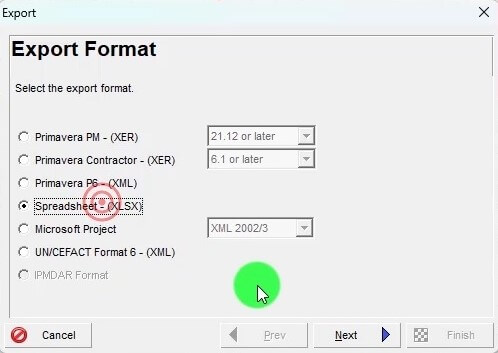
Export type Activity relationships
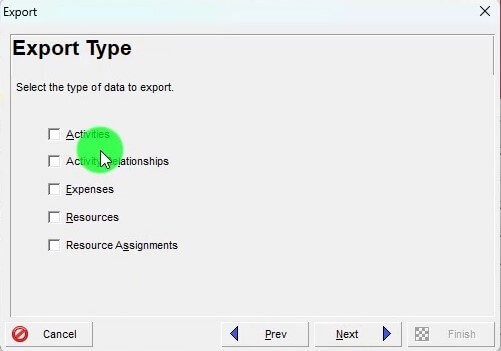
Export the listed project
Select Template and modify the activity relationships as per below sequence
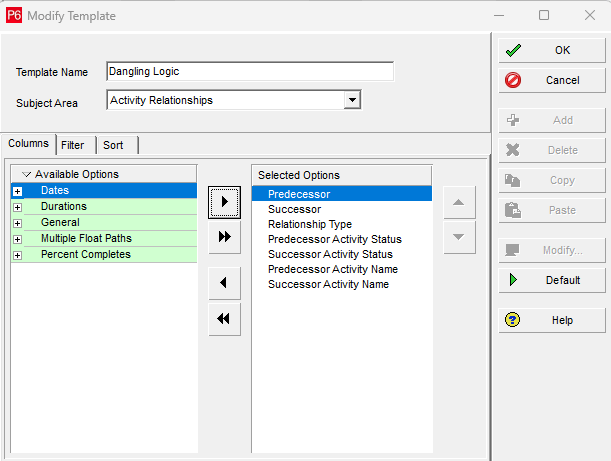
b. Copying Relationships to the Dangling Activities Detector Tool:
Second, copy relationships from the exported worksheet and paste them in the sheet “Relationships” in the “Dangling Activities Detector Tool” file.
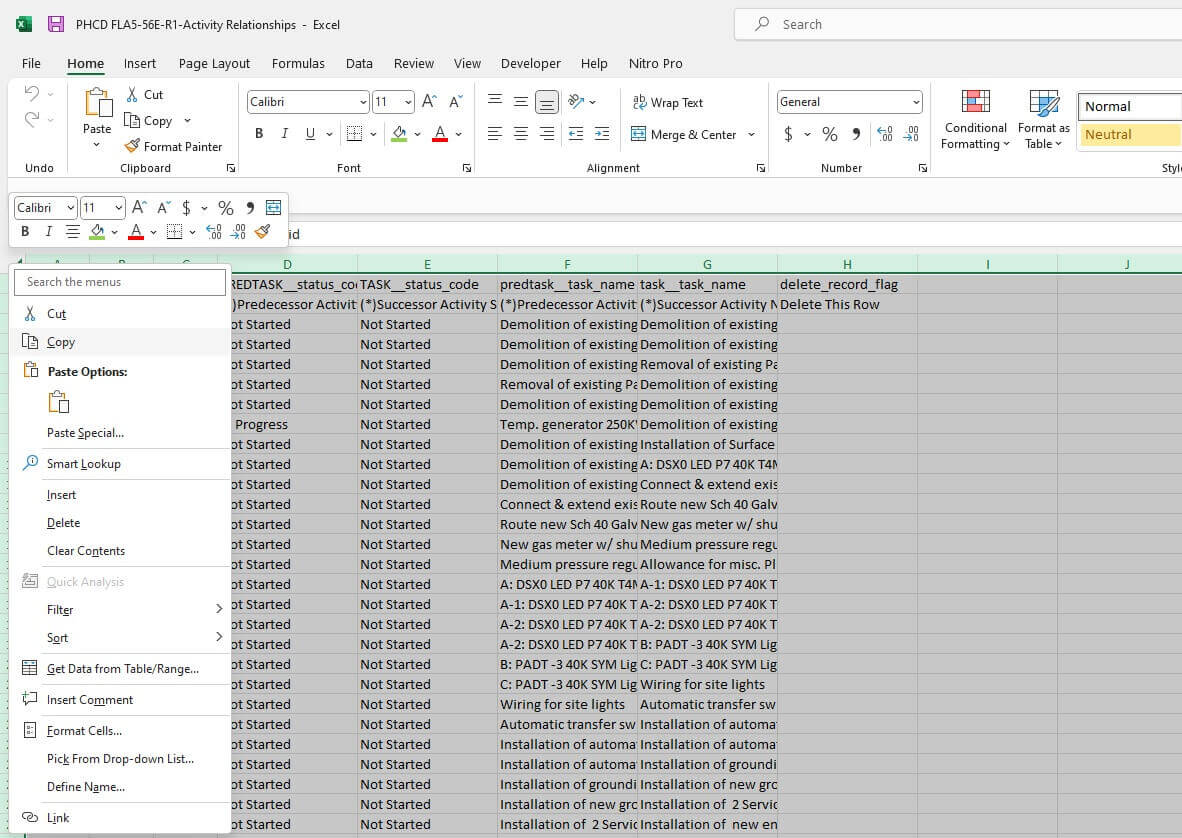
Now download and extract Dangling activities detector tool.
Download Dangling Activities Detector Tool
Please find below Download link
Paste the relationships into the Dangling activities detector tool.
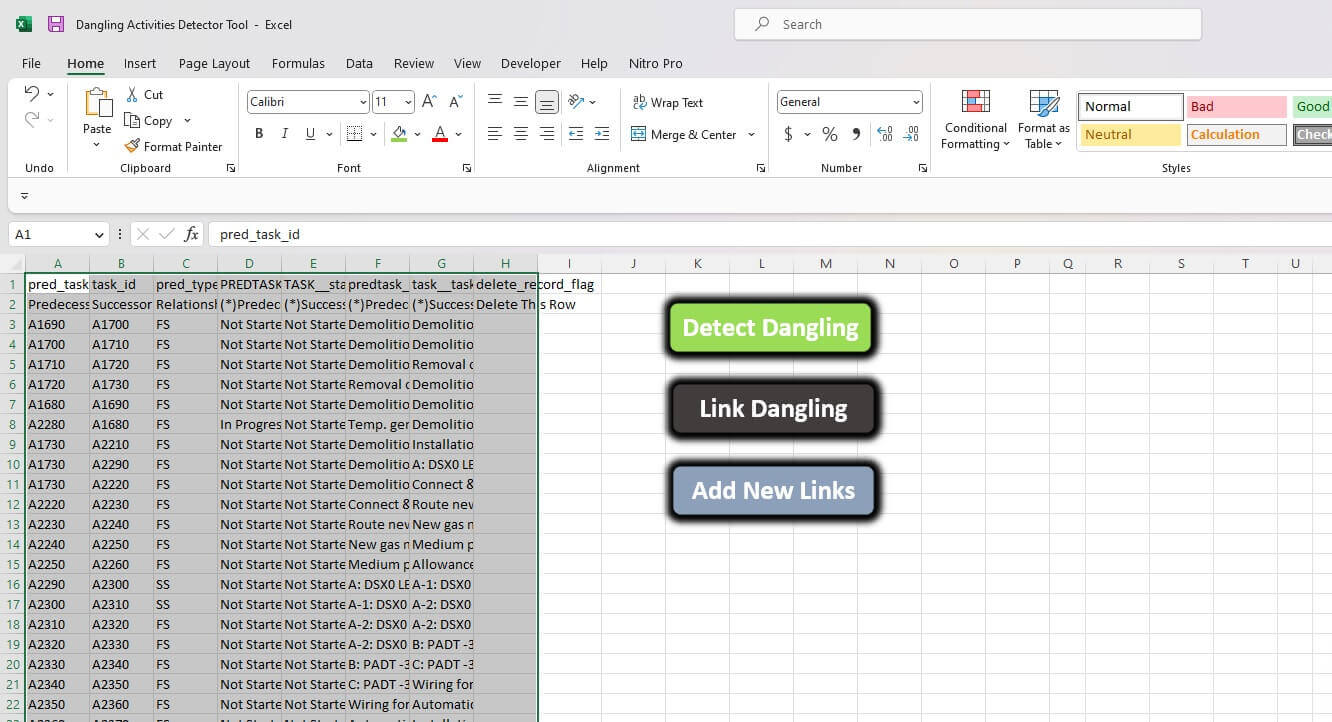
c. Detecting Dangling Activities:
Third, press the “Detect Dangling” icon in the upper-left of the sheet. The macro will extract any dangling activities in the program and provide them in two new sheets, one for dangling start and the other for dangling finish.
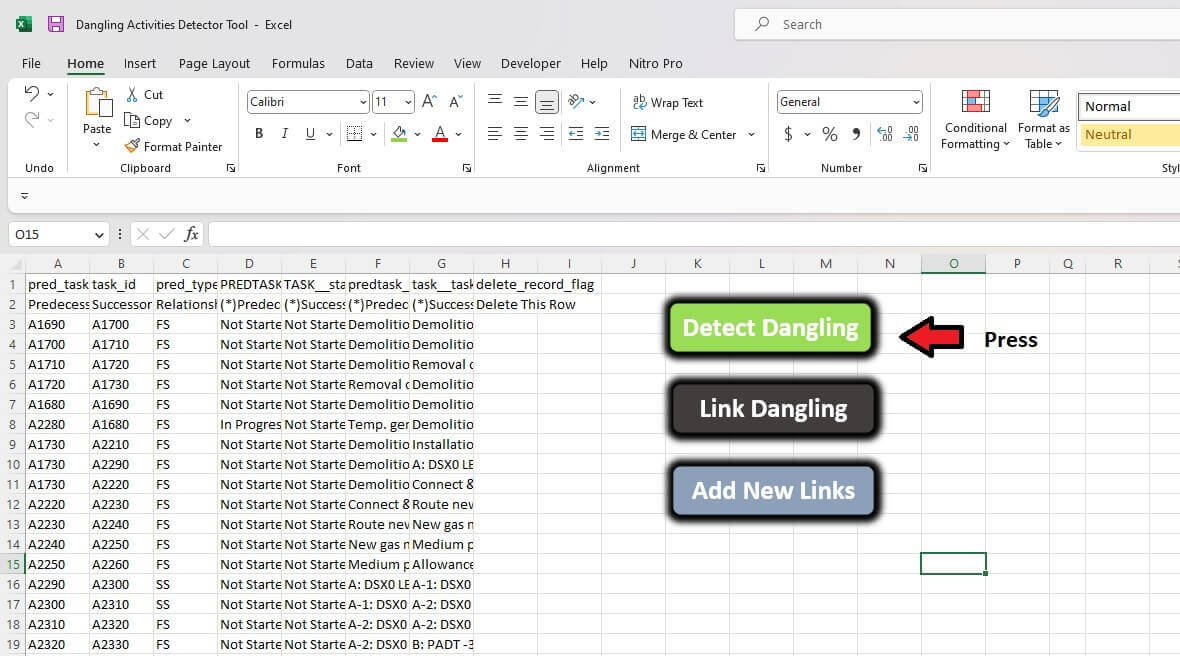
d. Studying the Results:
Fourth, study the results carefully to ensure that they are correct.
e. Linking Dangling Activities:
Fifth, link the dangling activities in your way to fix them.
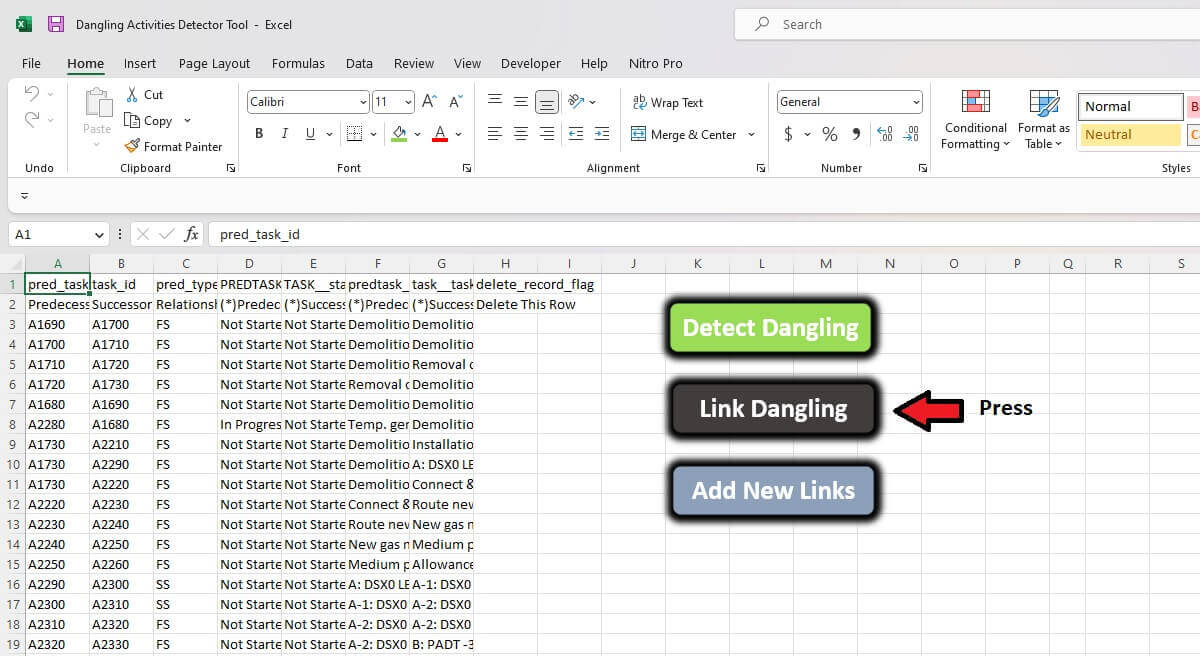
f. Adding New Links:
Sixth, add new links if needed to ensure that the program is accurate.
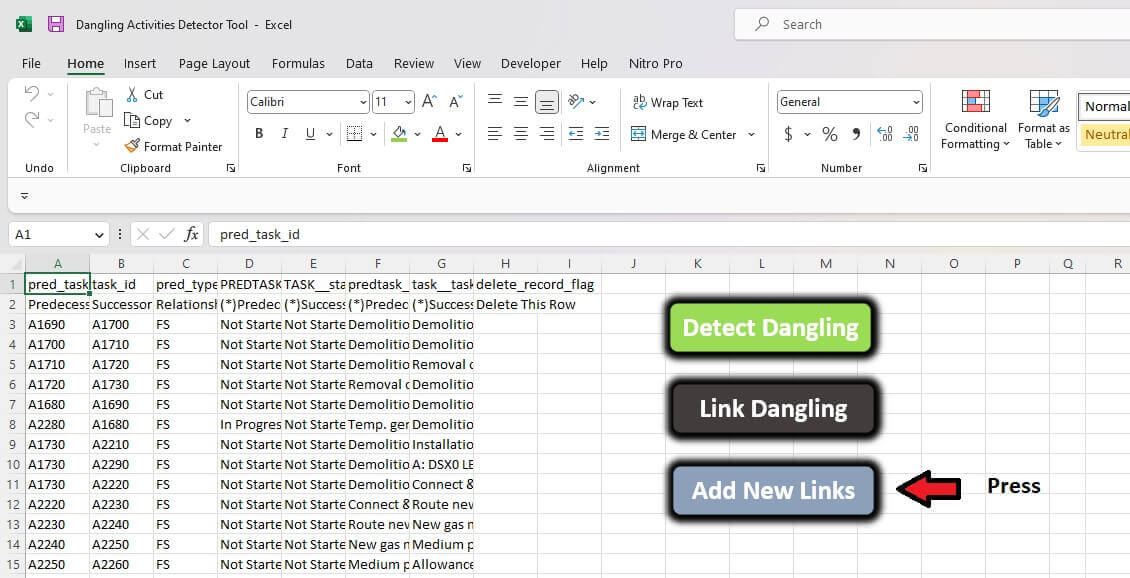
g. Import Back To Primavera P6
Copy the dangling detector tool relationships an paste into exported relationships
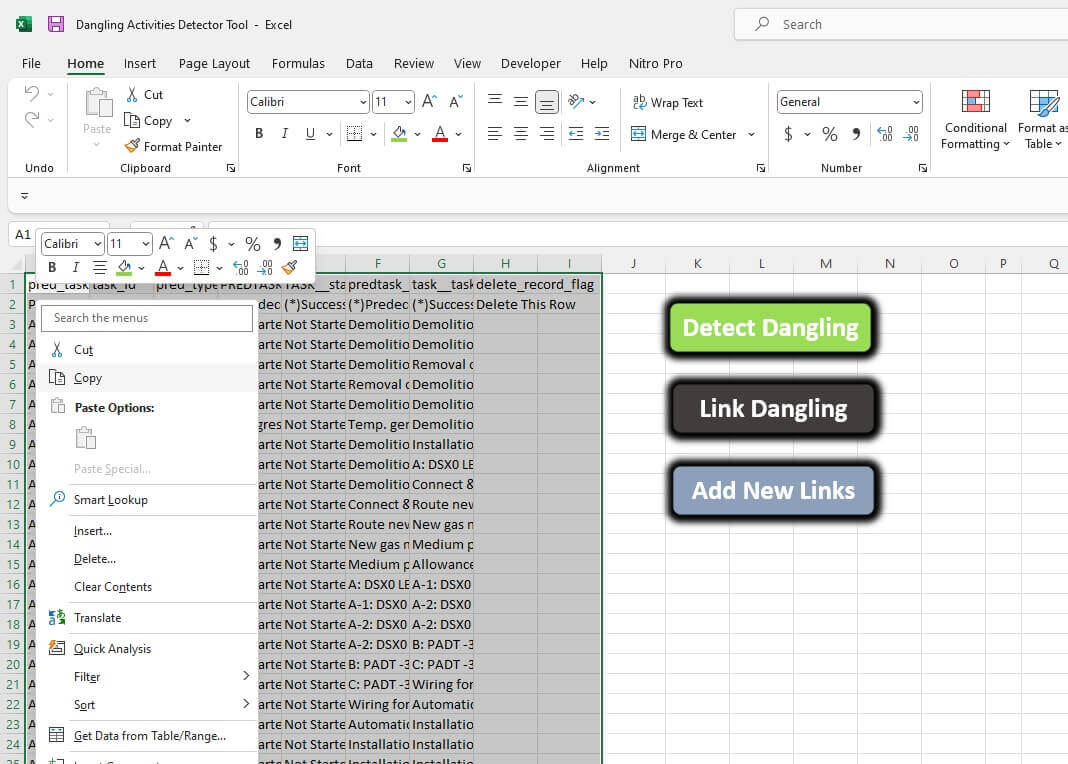
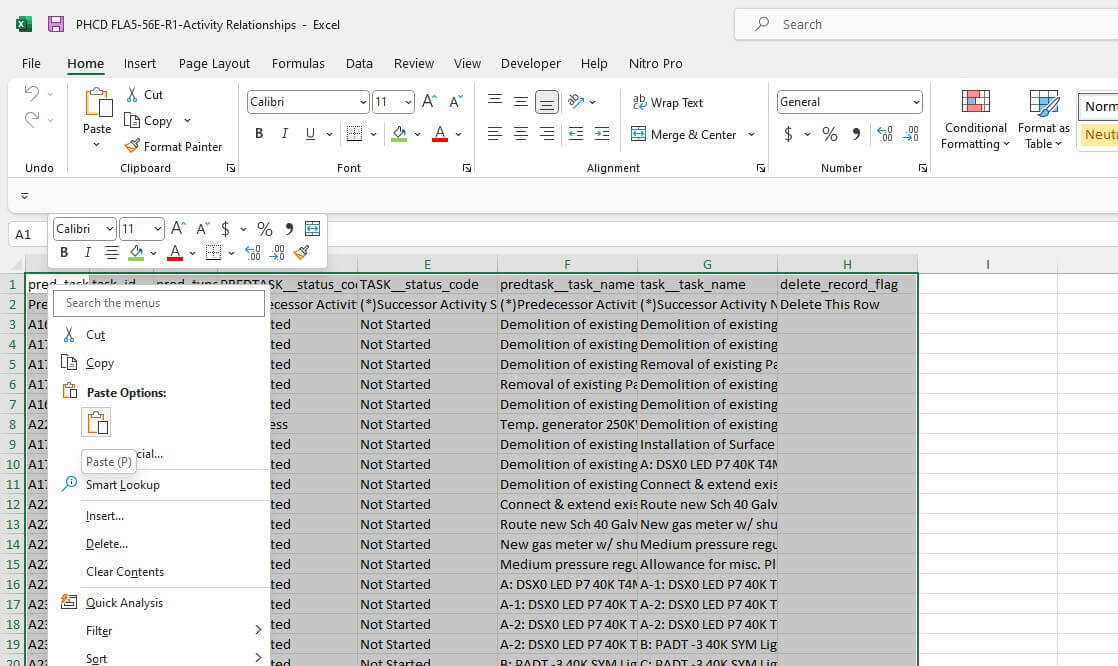
Import the xlsx file and update existing project by selecting project.
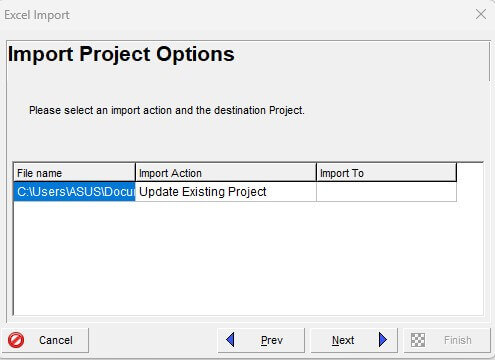
h. Important instruction while importing relationships into Primavera P6
Please note that adding new links to the schedule may impact the project completion date. Therefore, it is recommended to review the activity sequence and duration again to fix any changes that may have resulted from the addition of new links.
Save a backup copy of the project before re-importing relationships to Primavera.
Tutorial for Detecting and Fixing Dangling Activities in Primavera P6 Time Schedule
Watch complete demonstration on Detecting and Fixing Dangling Activities in Primavera P6 Time Schedule Please find below video tutorial for whole article.
Most Frequently asked questions related to the article.
What are dangling activities in a time schedule?
Dangling activities in a time schedule are activities that have a predecessor and a successor but are not linked with (FS) or (SS) for start or (FF) or (SF) for finish, which means they are not governed by relationships to other activities.
Why is the presence of dangling activities in a time schedule a problem?
The presence of dangling activities in a time schedule can cause inaccuracies that result in incorrect critical paths and milestone and completion dates, potentially impacting the project’s success.
How can scheduling software like Primavera and MS Project help in detecting dangling activities?
Scheduling software like Primavera and MS Project can help in detecting dangling activities by offering filters that highlight them in the activity list.
What is the Dangling Activities Detector Tool?
The Dangling Activities Detector Tool is a tool that can be used to identify dangling activities in a time schedule easily and efficiently.
How does the Dangling Activities Detector Tool help in identifying dangling activities?
The Dangling Activities Detector Tool helps in identifying dangling activities by extracting them from the activity list and presenting them in two new sheets, one for dangling start and the other for dangling finish. The tool also provides suggestions for linking dangles, which can be added to the relationships sheet and imported back to Primavera. This process helps in fixing the dangling activities and avoiding inaccuracies in the schedule
What is a Dangling Start Activity?
A Dangling Start Activity is an activity with a “Start End” that is not dominated by the predecessor relationships. It is not linked with (FS) or (SS) with its predecessor. This activity could have (SS) or (SF) relation with its successor but is still a dangling start activity because no activity in the network controls its start.
How is a Dangling Start Activity identified in a time schedule?
A Dangling Start Activity can be identified in a time schedule by analyzing the predecessor relationships of an activity. If it is not linked with (FS) or (SS) with its predecessor, it is a Dangling Start Activity.
What is a Dangling Finish Activity?
A Dangling Finish Activity is an activity with a “Finish End” that is not dominated by the successor relationships. It is not linked with (FS) or (FF) with its successors. This activity could have (FF) or (SF) relation with its predecessors but is still a Dangling Finish Activity because it can finish anytime without affecting other activities in the network.
How is a Dangling Finish Activity identified in a time schedule?
A Dangling Finish Activity can be identified in a time schedule by analyzing the successor relationships of an activity. If it is not linked with (FS) or (FF) with its successors, it is a Dangling Finish Activity.
What happens if a Dangle End (finish or start) is delayed or expedited?
If a Dangle End (finish or start) is delayed or expedited, it will not impact the project because it is not linked to the workflow sequence. This will lead to fake results of the expected project completion date and/or project critical path.
Why is it important to fix dangling activities in a time schedule?
Fixing dangling activities is crucial as it can distort the time schedule of a project, resulting in inaccurate critical paths and milestone and completion dates. Dangling activities are activities with a predecessor and a successor, but still dangling from at least one end. It can be an activity with a start end not dominated by the predecessor relationships or a finish end not dominated by the successor relationships. A delay or advancement in a dangling end will not affect the project, which leads to false completion dates and critical path.
What is the impact of dangling activities on a project’s critical path?
The presence of dangling activities in an active schedule can cause inaccuracies and potentially result in incorrect critical paths and milestone and completion dates. Since a dangling activity is not governed by relationships, it acts similarly to an open-ended activity. As a result, if there are any delays or advancements in the dangling end, it will not impact the project, leading to false critical path and completion dates.
What are the steps involved in using the Dangling Activities Detector Tool?
The steps involved in using the Dangling Activities Detector Tool are as follows:
Export “Activity Relationships” from Primavera.
Copy relationships from the exported worksheet and paste them in the sheet “Relationships” in the “Dangling Activities Detector” file.
Press the “Detect Dangling” icon in the upper-left of the sheet. The macro will extract any dangling activities in the program and provide them in two new sheets, one for dangling start and the other for dangling finish.
Study them carefully to ensure the results are correct.
If you want the macro to provide suggestions for relationships linking dangles, then press the “Link Dangling” icon.
The macro will provide new suggested relationships to link dangles in two new sheets. Check these new relations carefully to ensure they are in proper and realistic order. You may modify or replace some of them.
Once you feel satisfied with the results, press the “Add New Links” icon. The macro will add these new links to the “Relationships” sheet.
Copy relationships from the sheet “Relationships” in the “Dangling Activities Detector” file and paste them in the exported worksheet again.
Import this sheet again to Primavera and run the schedule. Note that the project completion date may be impacted by adding these new links, so you have to study activity sequence and duration again to fix that.
What information needs to be exported from Primavera in order to use the Dangling Activities Detector Tool?
To use the Dangling Activities Detector Tool, you need to export “Activity Relationships” from Primavera with the selected options in the same sequence as the sheet in the tool.
How are relationships copied and pasted into the Dangling Activities Detector Tool?
After exporting the “Activity Relationships” from Primavera, copy relationships from the exported worksheet and paste them in the sheet “Relationships” in the “Dangling Activities Detector” file. Then press the “Detect Dangling” icon to extract any dangling activities in the program and provide them in two new sheets, one for dangling start and the other for dangling finish. You can also press the “Link Dangling” icon if you want the macro to provide suggestions for relationships linking dangles. Once you feel satisfied with the results, press the “Add New Links” icon to add these new links to the “Relationships” sheet. Copy relationships from the sheet “Relationships” in the “Dangling Activities Detector” file and paste them in the exported worksheet again. Finally, import this sheet again to Primavera and run the schedule.
What is the purpose of the “Detect Dangling” Button in the Dangling Activities Detector Tool?
The purpose of the “Detect Dangling” button in the Dangling Activities Detector Tool is to detect any dangling activities in the program and provide them in two new sheets, one for dangling start and the other for dangling finish.
What does the Dangling Activities Detector Tool do once the “Detect Dangling” Button is pressed?
Once the “Detect Dangling” button is pressed, the Dangling Activities Detector Tool extracts any dangling activities in the program and provides them in two new sheets, one for dangling start and the other for dangling finish.
How many new sheets are created by the Dangling Activities Detector Tool once the “Detect Dangling” Button is pressed?
The Dangling Activities Detector Tool creates two new sheets once the “Detect Dangling” button is pressed, one for dangling start and the other for dangling finish.
What is the purpose of the new sheets created by the Dangling Activities Detector Tool?
The purpose of the new sheets created by the Dangling Activities Detector Tool is to provide a list of dangling activities, which can then be linked to their respective predecessors or successors to fix any inaccuracies in the project timeline.
What should be done after the new sheets are created by the Dangling Activities Detector Tool?
After the new sheets are created by the Dangling Activities Detector Tool, the user should study them carefully to ensure the results are correct. The user may then link these activities in their own way to fix them, or use the “Link Dangling” button to receive suggestions for relationship linking. Once the user feels satisfied with the results, they can press the “Add New Links” icon, and the macro will add these new links to the “Relationships” sheet. Finally, the user can copy relationships from the sheet “Relationships” in the “Dangling Activities Detector” file and paste them in the exported worksheet again, import this sheet again to Primavera and run the schedule. Note that the project completion date may be impacted by adding these new links, so the user will need to study the activity sequence and duration again to fix that. It is also recommended to save a copy of the project as a backup before re-importing relationships to Primavera.
How can the Dangling Activities Detector Tool provide suggestions for relationships linking dangles?
The Dangling Activities Detector Tool provides suggestions for relationships linking dangles by pressing the “Link Dangling” icon. This macro will provide new suggested relationships to link dangles in two new sheets. You may modify or replace some of them to ensure they are in proper and realistic order.
What is the purpose of the “Link Dangling” icon in the Dangling Activities Detector Tool?
The “Link Dangling” icon in the Dangling Activities Detector Tool is used to provide suggestions for relationships linking dangles.
How many new sheets are created by the Dangling Activities Detector Tool once the “Link Dangling” icon is pressed?
The Dangling Activities Detector Tool creates two new sheets once the “Link Dangling” icon is pressed.
What is the purpose of the new sheets created by the Dangling Activities Detector Tool after the “Link Dangling” icon is pressed?
The purpose of the new sheets created by the Dangling Activities Detector Tool after the “Link Dangling” icon is pressed is to provide suggestions for relationships linking dangles. These new suggested relationships can be modified or replaced to ensure they are in proper and realistic order.
How can the results of the Dangling Activities Detector Tool be modified or replaced?
The results of the Dangling Activities Detector Tool can be modified or replaced by checking the new suggested relationships and modifying or replacing them as necessary before adding them to the “Relationships” sheet. You may modify or replace some of them to ensure they are in proper and realistic order.
What should be done after the modifications or replacements are made to the results of the Dangling Activities Detector Tool?
After modifications or replacements have been made to the results of the Dangling Activities Detector Tool, the new links need to be added to the time schedule.
How can the new links suggested by the Dangling Activities Detector Tool be added to the time schedule?
The new links suggested by the Dangling Activities Detector Tool can be added to the time schedule by pressing the “Add New Links” icon. The macro will add these new links to the “Relationships” sheet.
What should be done after the new links are added to the time schedule?
After the new links are added to the time schedule, the relationships need to be copied from the sheet “Relationships” in the “Dangling Activities Detector” file and pasted in the exported worksheet again. This sheet can then be imported again to Primavera and the schedule can be run. The project completion date may be impacted by adding these new links, so the activity sequence and duration should be studied again to fix that.
What is the impact of adding new links to a time schedule?
Adding new links to a time schedule may impact the project completion date, and therefore, the activity sequence and duration should be studied again to fix that.
Where can the Dangling Activities Detector Tool be downloaded from?
The Dangling Activities Detector Tool can be downloaded from the attached sheet provided in the article.
Conclusion
In conclusion, detecting and fixing dangling activities in a time schedule is crucial for the success of the project. The Dangling Activities Detector Tool provides an easy solution to detect and fix them, which will help ensure the accuracy of the program.

